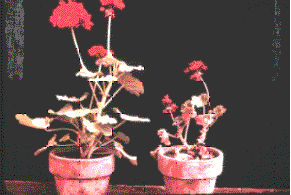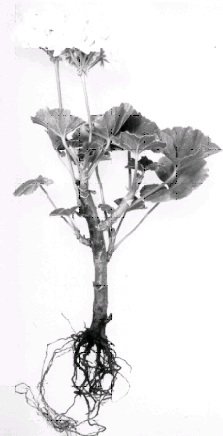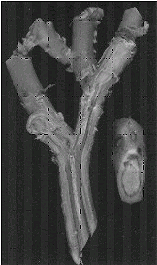Reports on Plant Diseases |
RPD No. 607 - Bacterial Diseases of Geranium
|
April 1990
|
BACTERIAL BLIGHT OR WILT [ Symptoms ][ Disease
Cycle ]
SOUTHERN BACTERIAL WILT [ Symptoms ][ Disease
Cycle ]
BACTERIAL LEAF SPOT [ Symptoms ][ Disease
Cycle ]
[ Control ] [ Table 1 ] [
Table 2 ]
|
Geraniums (Pelargonium species) are the most popular flowering
pot plants grown in the United States. Plant diseases are one of the key
limiting factors to the high-quality production of these plants in the
home and commercially.
Three bacterial diseases are known to attack geraniums: bacterial blight
or wilt, southern bacterial wilt, and bacterial leaf spot. Bacterial blight
or wilt is the only one of these diseases currently known to occur in
the Midwest.
BACTERIAL BLIGHT OR WILT
This disease, caused by Xanthomonas campestris pv. pelargonii,
is a major problem of geraniums in Illinois during warm, humid weather.
It has caused losses of 10 to 100 percent, depending on the cultivar.
The symptoms are often masked indoors by low winter temperatures. Bacterial
blight attacks the leaves and stems of the common garden or florist's
geranium (Pelargonium hortorum) as well as the ivy geranium (P.
peltatum). There is resistance to bacterial blight in the Lady Washington
and Martha Washington geraniums (P. domesticum), as well as P.
acerifolium, pelargonium "Torento", P. tomentosum,
and P. scarboroviae.
|

Figure 1. Bacterial
wilt of geranium.
|

Figure 2.
Geranium plant affected by bacterial stem rot. Tissues of stem and upper
roots are blackened (Illinois Natural History Survey photo)
|
Symptoms
Disease symptoms usually appear in warm, sunny weather when the plants
are under moisture stress. Leaves infected with bacterial blight show
two types of symptoms:
1. Small, round, water-soaked spots form on the underside of the leaf.
Several days later, the spots develop into angular, slightly sunken, well-defined
lesions about 1/16 to 1/8 inch (up to 3 mm) in diameter that may be surrounded
by a diffuse yellow halo. The spots eventually turn dark brown to black
and become hard and dry. Leaves quickly wilt, die, and may fall off, or
hang on the plant for a week or more (Figure 1). The bacteria in these
leaf lesions may migrate into the water-conducting tissues, move down
through the petiole and into the stem, eventually causing the plant to
die from the stem rot phase of the disease.
2. A wilting of the leaf margin occurs in some cultivars, resulting in
large angular (V-shaped), yellow or dead areas bounded by the veins. These
leaves soon wither and hang on the petiole or drop off. Other factors,
such as potash deficiency and Botrytis blight, may cause angular, dead
patches, in geranium leaves; but the wilted condition is always associated
with bacterial blight infections (Figure 2).
The stem rot phase of the disease is commonly called "black rot"
by growers. Water-conducting tissues within the branches and stems of
infected plants turn brown to black, 2 to 4 weeks after infection. At
this stage, one or more leaves on the branch will usually wilt and develop
angular dead areas. The bacteria soon spread from the water-conducting
tissue to other stem tissues. The stem rapidly turns a dull gray to blackish
brown. The roots are blackened but not decayed (Figure 3).
Plants gradually become defoliated, except for a few dwarfed leaves at
the tips of the upright blackened branches (Figure 4). The stem and branches
rapidly blacken and shrivel into a dry rot with all the tissues destroyed,
except for the fibers and epidermis. Some plants may partially recover
from initial infection and produce new, healthy-looking branches. Since
these branches harbor the bacterium, such plants usually die within 3
to 6 months.
Cuttings infected with bacterial blight fail to root, the stems slowly
rot, turn a dull blackish brown from the base upwards (Figure 5), and
eventually die. The leaves wilt, often showing the typical symptoms described
earlier. Cuttings serve as a source of infection in the propagation bed.
Back to Top |
Disease Cycle
Infection occurs through plant openings or through wounds that are created
when cuttings are taken from stock plants. A cutting knife that is not
disinfected is one of the surest means of transmitting the bacteria. The
bacterium survives in water-conducting and other tissues of infected cuttings
that are taken from symptomless stock plants. Infected plants are symptomless
during cool weather when the temperatures are below 70 F (21 C) or at
very high temperatures (90-100 F or 32-38 C). The bacteria are very infectious
and are spread easily from plant to plant through plant contact and contaminated
propagation media, by splashing during hose watering or misting, cultural
operations, contaminated cutting knives, and insects. The bacteria are
spread or handling them. The organism has been isolated from whiteflies
(Trialeurodes vaporariorum), which may transmit the bacteria to
healthy geraniums. The organism can survive in moist soil from 3 to 6
months, or until infected plant residues are completely decayed. Symptoms
and disease spread occur most rapidly at temperatures of 70 to 85 F (21-29
C) and in plants overfed with nitrogen fertilizer.
Back to Top
|

Figure 3.
Geranium plant affected by bacterial stem rot. Tissues of stem and upper
roots are blackened (Illinois Natural History Survey photo)
|
SOUTHERN BACTERIAL WILT
Southern bacterial wilt caused by Pseudomonas solanacearum was first
reported in geranium in 1979. The symptoms are similar to bacterial blight or
wilt. Although it is not a major disease of geraniums, it could pose a threat
to geranium growers in the South and the Midwest, due to the exchange of cuttings
and plants from these geographic regions. The common geranium (Pelargonium
hortorum), is susceptible to this disease. No geranium cultivars are resistant.
Symptoms
The initial symptoms include a wilting of the lower leaves followed by
chlorosis and finally necrosis of the leaves. The stem eventually turns
brown and then black at the soil line, and the plant collapses when 1/2
to 1 inch of the basal stem is infected. The roots can also become necrotic.
Flowers fail to open normally. Stem sections reveal vascular discoloration
(Figure 4). The symptoms of southern bacterial wilt always progress upward
from the soil line, whereas those of bacterial blight or wilt move in
either direction — up or down the stem. It is unknown if infected
plants can remain symptomless.
Disease Cycle
Pseudomonas solanacearum is a soilborne bacterium that may persist
in soil for 6 years or more in the absence of a suitable host plant. The
pathogen survives and spreads within susceptible plants and cuttings.
Infection normally occurs through the roots. The organism is transmitted
on infected cutting knives, in soils and other planting media, in crop
debris, by splashing or flowing water and by insects. P. solanacearum
has a very wide host range.
Symptoms develop rapidly at 75 to 104 F (23-39 C), and plants die within
2 to 3 weeks under these conditions, whereas it may take 5 weeks for similar
development of bacterial blight or wilt.
Back to Top |

Figure 4.
Vascular necrosis of geranium infected with Pseudomonas solanacearum.(D.L.
Strider, North Carolina State University)
|
BACTERIAL LEAF SPOT
A bacterial leaf spot caused by Pseudomonas cichorii has been known
to only attack geranium in the past few years. It has been reported only in
Florida, but due to the exchange of plant material, the disease is a potential
threat to the florist industry in the Midwest. This bacterium also has a wide
host range.
�Back to Top
Symptoms
The appearance of leaf spot symptoms varies, depending on the weather conditions.
Plants growing outside exposed to rains exhibit dark brown to black, irregularly
shaped areas 5 to 10 mm or larger. The margins of the spots appear water-soaked
a few hours after a rain. The lesions may extend or enlarge along the veins
and may coalesce until the entire leaf may eventually die and curl up.
Under less favorable conditions for disease development, such as when plants
are exposed to dews or only occasional overhead watering, the lesions that develop
are sunken on both the upper and lower leaf surfaces. These spots may have tan
centers and may be slightly raised. A lesion may have a dark margin and a yellow
halo that may be as wide as the diameter of the lesion. The lesions commonly
enlarge in wet weather but are checked by dry weather. Eventually most spots
turn dark brown to black and large lesions, formed by the merging of smaller
lesions, may appear to have "eyes" 1 to 2 mm in diameter.
Flower clusters are susceptible and individual flowers fail to open when infection
occurs in the bud stage. Young seedlings can also become infected, causing a
soft, dark, wet decay of the developing leaves.
Back to Top
Disease Cycle
The bacterium is thought to be carried on clothes, hands, sprayers, and other
equipment. Environmental parameters specific for this disease on geranium are
presently unknown. Free moisture on the leaves and rainy periods are known to
promote disease development.
Back to Top
Control
The control measures outlined will control all three diseases: bacterial blight
or wilt, southern bacterial wilt, and bacterial leaf spot.
1. Purchase disease-free cuttings or plants from a reputable nursery or garden
supply store. Florists should obtain CVI (culture-virus-indexed) cuttings from
a commercial propagator who has established disease-free planting stock and
who practices strict sanitary measures or uses culture-indexed cuttings to set
up a mother block system. Start with new stock plants each year; do not keep
them from year to year.
2. Follow strict sanitary procedures to prevent the contamination of healthy
plants.
a. Immediately remove and destroy all infected plants, preferably by burning.
Remove all old leaf and plant debris.
b. Florists should use an automatic watering system. If this is impossible,
hang the host so that the nozzle does not touch the greenhouse floor. Avoid
overwatering and sprinkling or misting water on the foliage.
c. When propagating, select a raised bench away from other areas of geranium
production. The bench surface should be periodically wiped or sprayed with a
fresh household bleach (Clorox, Purex, Sunny Sol) solution prepared by adding
1 part of bleach to 9 parts of clean tap water. Also disinfect any equipment
used to transport, hold, or work with geraniums.
d. Steam the propagating medium, soil mix, clay pots, and tools for 30 minutes
at 180 F (82 C) or 160 F (72 C) for one hour.
e. Wash hands thoroughly with soap and hot running water before handling plants.
Take cuttings by (1) breaking off succulent tips of disease-free stock plants;
or (2) sterilizing the cutting knife or razor blade by dipping in a 70-percent
solution of rubbing alcohol and flaming or soaking for 5 minutes in a liquid
bleach solution (add 1 part of bleach to 9 parts of water).
Knives or razor blades should be changed between stock plants. Do not dip
cuttings in liquid solutions. Place cuttings in clean, sterile flats lined with
new newspapers.
f. After establishment, take cuttings from flats and plant them directly into
steam-treated soil mix in clean pots.
g. Maintain good cultural conditions and ventilation. Space the plants to
avoid plant contact. The greenhouse bench surface should be covered with woven
wire mesh.
h. Control whiteflies and other insects to lessen spread of bacteria. Follow
the suggestions of Extension Entomologists at the University of Illinois.
i. Avoid forcing the plants too rapidly, especially during warm (70-85 F,
21-29 C) and humid weather. Maintain a balanced fertility based on a soil test.
j. In a field, flower bed, or nursery, wait at least a year before replanting
with geraniums.
3. Infrequent sprays containing basic copper sulfate or other fixed copper
fungicide may aid in control of bacterial leaf spot caused by P. cichorii.
Frequent use (every 7 to 10 days), however, causes a surface glazing of the
leaves and a stunting of growth.
Back to Top
Table 1.
|
Some common plants susceptible to southern bacterial wilt
|
| African-violet |
cosmos |
lantana |
ragweeds |
| ageratum |
cotton |
lead-tree |
rhubarb |
| alfalfa |
cowpea |
lupines |
sainfoin |
| arrowroot |
crotalaria |
marigold |
salvia |
| aster |
crotons |
meadow-weed |
schizanthus |
| bananas |
cyclamen |
milkweed |
sesame |
| beans, garden |
dahlia |
mulberry, white |
soybean |
| beans, broad |
dasheen |
nasturtium, garden |
spurge, garden |
| bean, horse or jack |
dayflower |
nightshade, black |
Spanish needle |
| bean, hyacinth |
eggplant |
nightshade, deadly |
sunflowers |
| bean, mung |
fennel |
olive |
sweetpotato |
| bean, sword |
flamingo-lily |
oxalis |
teak |
| beet, garden |
fuchsia |
painted-tongue |
thornapples |
| beggarticks |
garden balsam |
peanut |
tobaccos |
| bird-of-paradise |
gerbera |
pepper |
tomato |
| bur-marigold |
ginger |
periwinkle |
tomato, cherry |
| cabbage |
groundcherries |
petunia |
tomato, pear |
| cabbage, Chinese |
gourd, club |
phlox |
tomato-tree |
| canna |
gynura |
plantains |
turkeyberry |
| cassava |
heliotrope |
pokeweed |
vanilla |
| castor bean |
henbane |
potato |
velvet bean |
| chrysanthemum, florist's |
hibiscus |
pot-marigold |
verbena |
| hollyhock |
prickly sida |
xanthosoma |
| cocklebur |
horsenettle |
proboscis-flower |
watermelon |
| comfrey |
hydrangea |
pumpkin |
zinnia |
Table 2.
|
Some common plants susceptible to Pseudomonas cichorii
|
| Aglaonema commutatum |
coffee |
Monstera deliciosa |
Pyracantha sp |
| cyclamen |
oxslip |
Ruellia humilis |
| apple, paradise |
daisy, Shasta |
pear |
rutabaga |
| Barleria cristata |
daisy, Transvaal |
pernettya |
Schefflera |
| broccoli |
eggplant |
mucronata |
arboricola |
| cabbage |
endive |
Philodendron panduraeforme |
Scindapsus sp. |
| camellia |
escarole |
Spathiphyllum sp. |
| carrot |
gladiolus |
poppy, arctic |
tobaccos |
| cauliflower |
hydrangea |
poppy, cow |
tomato |
| celery |
iris |
poppy, oriental |
Viburnum sp. |
| chicory |
larkspur |
potato |
watermelon |
| crysanthemum, florists's |
lettuce |
Potentilla sp. |
wheat |
| magnolia, southern |
pot marigold |
|
Back to Top
For further information about woody plants, contact Nancy R. Pataky, Extension
Specialist in Turf and Ornamentals and Director of the Plant Clinic, Department
of Crop Sciences, University of Illinois, Urbana-Champaign.
|



